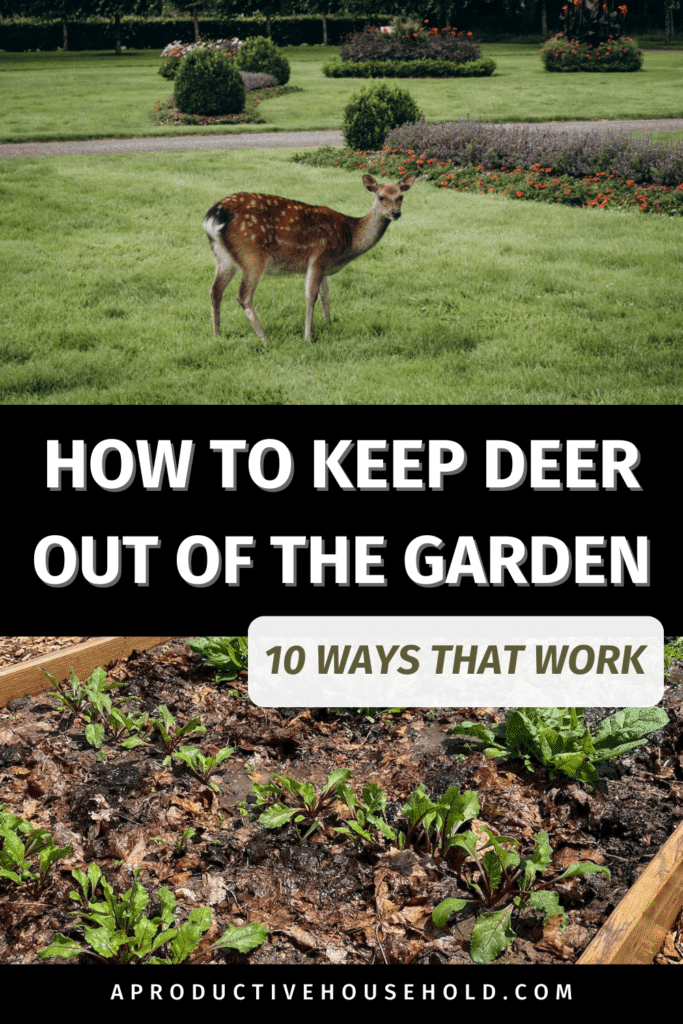How to Keep Deer Out of Your Garden: 10 Ways That Work
Deer damage can be devastating after investing time, money, and energy into your garden. Thankfully, there are a number of different methods that work to keep these deer out of your garden beds, whether you live in a suburban area or on the edge of the woods (like we do!).
With our garden sitting smack dab between the woods and multiple farm fields, there are lots of deer roaming about, and we’ve spent the last 6 years trying different methods for keeping these graceful creatures away from our plants. With lots of deer roaming around, it’s taken some trial and error for sure. Here are some of the methods we’ve learned that have the best potential for success. (Bonus: our most successful try is also the prettiest! See #1 below.)
Pin This Post for Later!
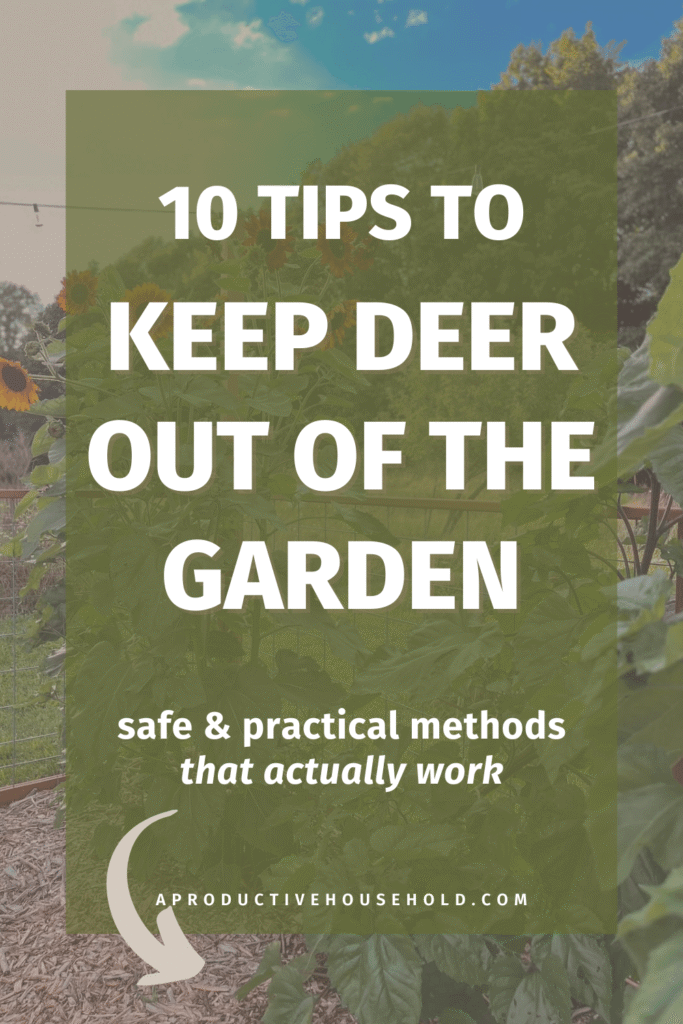
This post contains affiliate links, which means that we make a small commission at no extra cost to you. You can view our full disclosure here.
How Do Deer Work? What You Need to Know About Deer Behavior
Understanding how deer work can go a long way toward knowing how to direct them away from your garden. Here’s what you need to know.
When are deer most active?
Deer are crepuscular, which means you’ll notice the most deer activity right before the sun comes up and before it goes down in the evening. So, dusk and dawn are typically the times when your garden will be most vulnerable. (If you want to find out how or where they’re getting in, peeking out during dawn and dusk is the best way to spy on them!)
Do deer have good eyesight?
Deer don’t have particularly good eyesight in the daytime in the same way that we do. In fact, because of their wide pupils, they see about 3x less clearly than we do in the daylight.
However, because deer are prey animals, they’re designed to be able to see a wide angle and to see well in the semi-darkness (at dusk and dawn). Because of a reflective layer in the back of their eye, they actually see about 18x BETTER than we do at twilight! In addition, because of the location of their eyes on the sides of their heads, they have a 300° field of vision.
What do deer like to eat? And how much of it?
White-tailed deer eat about 6-8% of their body weight per day. For an adult deer of 100-200 pounds, this translates to anywhere from 6-16 pounds of vegetation per day. That is a ton! Deer will eat almost anything they can find, but since they’re so used to darting at the first sign of danger, they especially gravitate toward high-value plants that are easy to get and provide a significant meal in a short amount of time.
A hungry deer will go after a variety of plants, including leaves, twigs and branches, grasses, nuts, and crops. Not surprisingly, they’re especially attracted to fruit trees and berries, clover, alfalfa, and other crops. Unfortunately for gardeners, some of their favorite plants include young trees that offer easier-to-reach leaves and fruits, and flower beds that have new, tender growth.
How high can deer jump?
Whitetail deer can jump 8 feet vertically from a stand, and even higher with a running start. If you’re going to build a fence around your flower or vegetable garden tall enough to keep deer out, your best bet is to make the highest level at least 8 feet tall.
10 Ways to Keep Deer Out of Your Garden
From physical barriers and landscaping techniques to deterrents that offer a high visual impact, here are 10 of the most effective ways to keep deer away from your garden beds.
1. Solar String Lights
Not gonna make you wait until #10 to find out our favorite solution… let’s just start with it! This year, we tried solar string lights for our garden to help keep the deer out. Not only has it worked flawlessly, but it’s beautiful, aesthetically pleasing, and so cheap compared to similar options!
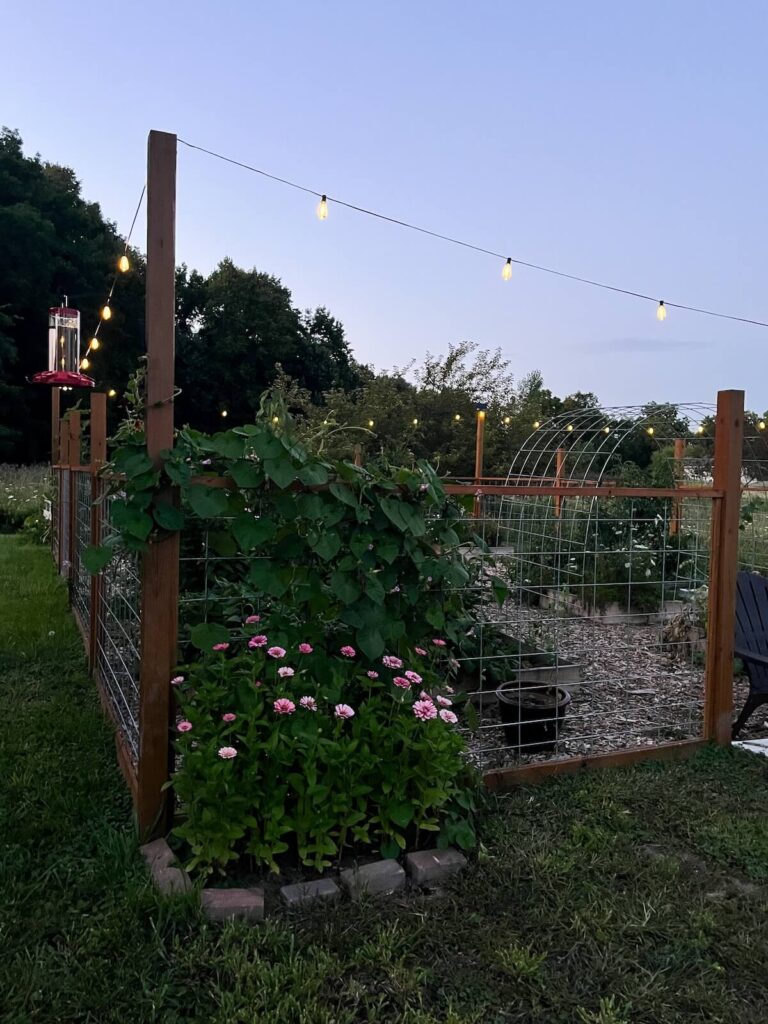
Deer can jump 8 feet (or more) vertically, but obviously, building an 8′ fence is expensive. An alternative option is to build a shorter fence…3′, 4′, or 5’… and then add add a layer or two of electric wire above it to increase the hight less expensively.
While this is typically effective for deer resistance, it’s expensive. Electric fence typically costs $1-4 per linear foot, requires proper installation (installing a charger, grounding, insulating, maintenance, etc.), and of course, incurs the ongoing cost of electricity.
We re-did our garden this year and invested in 12′ corner posts (sunk to 8′ tall). Then we built a 4.5′ fence and bought a $35 string of solar lights from Amazon and installed them at about 8′. (We bought 120’—make sure to buy more than the perimeter of your garden so they have some room to hang a bit loosely.)
At the end of the season, we’ve found this to be the absolute best solution! Solar lights are:
- Way less expensive than electric fencing. The string lights we used are less than $0.30 per square foot, compared to an average of $2.50 (sometimes much more) for electric fencing.
- No electricity cost. These are solar—no electricity costs and completely hands off! We have ours set to come on at twilight each evening and turn off at daybreak.
- Aesthetic. Honestly, I would have bought them even if not for the deer. They add so much beauty to our garden space. We have had so many comments on these—they look like they should cost way more than $35!
- Easy to hang. It took about a half hour to string these around the garden. If you don’t have tall corner posts to attach them to, you could even hang them from nearby trees (if they’re close enough to your garden), or use tall metal t-posts.
- They WORK! We have not had a single deer try to attempt getting into our garden this year. The string is easily visible even when it’s off and produces significantly bright light when it’s on, so it’s very effective for convincing our four-legged friends not to jump into it. One of the best choices we’ve ever made for our garden—for $35!
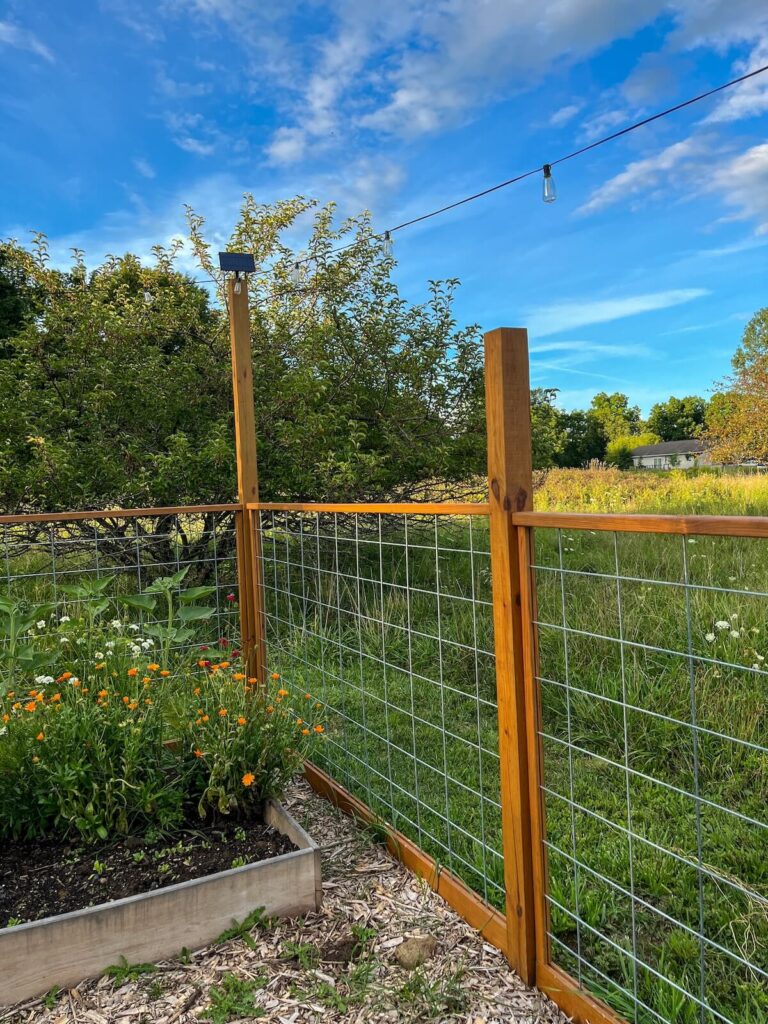
2. Tall Fencing
If you want to opt for a solid fence, make it tall! A high fence of at least 8 feet is typically pretty effective at keeping deer out.
What type of fence is best for deer?
Honestly, for garden deer fencing, the type and strength of the fence doesn’t determine it’s success as much as the height (in general). We used cattle panel for our current garden, but we’ve also used welded wire. Some gardeners even use metal posts or garden stakes with chicken wire.
Remember, you can always use a shorter fence and add electric wire or solar lights at higher levels to make a good deer fence.
Another option is to create a double fence by placing two shorter fences around your garden a few feet apart. While a 4′ fence by itself won’t deter deer, an outer and inner fence can make it harder for deer to judge the jump and discourage them from trying.
3. Limit Open Spaces
If you already have your garden built or are looking for a cheaper option, limiting open spaces within your garden can be another good deer deterrent method. If deer don’t see a good place to land, they’re not going to want to jump into an enclosed space.
Make large areas look smaller by adding large rocks or boulders, trees or tall plants, benches or other outdoor furniture, bird baths, large decorative pieces, large pots, or a compost bin.
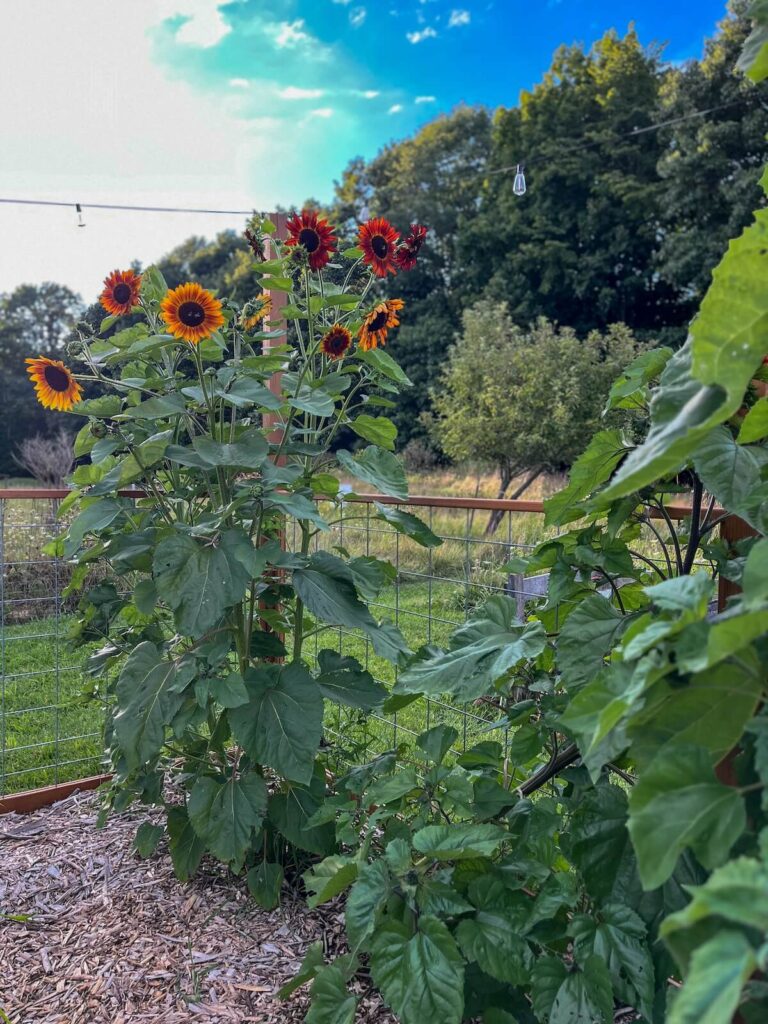
4. DIY Tomato Cages
Large, sturdy tomato cages are another great option making a large garden look less inviting to a family of deer. We made a bunch of DIY tomato cages years ago (similar to this design) and they’re my go-to for protecting anything from deer.
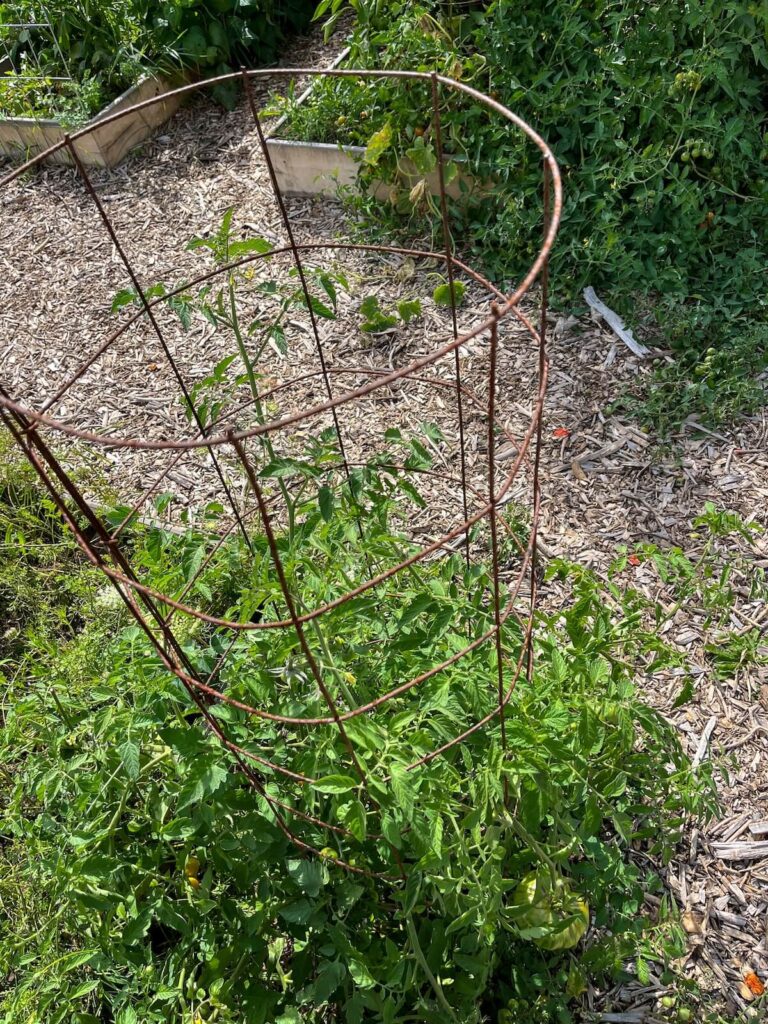
In fact, we were late on fencing our garden when we re-did it this year, so I just sprinkled a bunch of our tomato cages around different plants to make a nice little deer obstacle course.
I’ve also used them in previous gardens by sticking them in open spots after I noticed deer jumping into those places. It tends to work pretty well if you have enough for your space!
5. Raised Beds
If you want to put a little money and effort into creating or re-creating your garden, raised beds seem to be another helpful deer deterrent. Again, deer need a good place to land, so they’re typically wary of jumping into a fenced garden with raised beds in it.
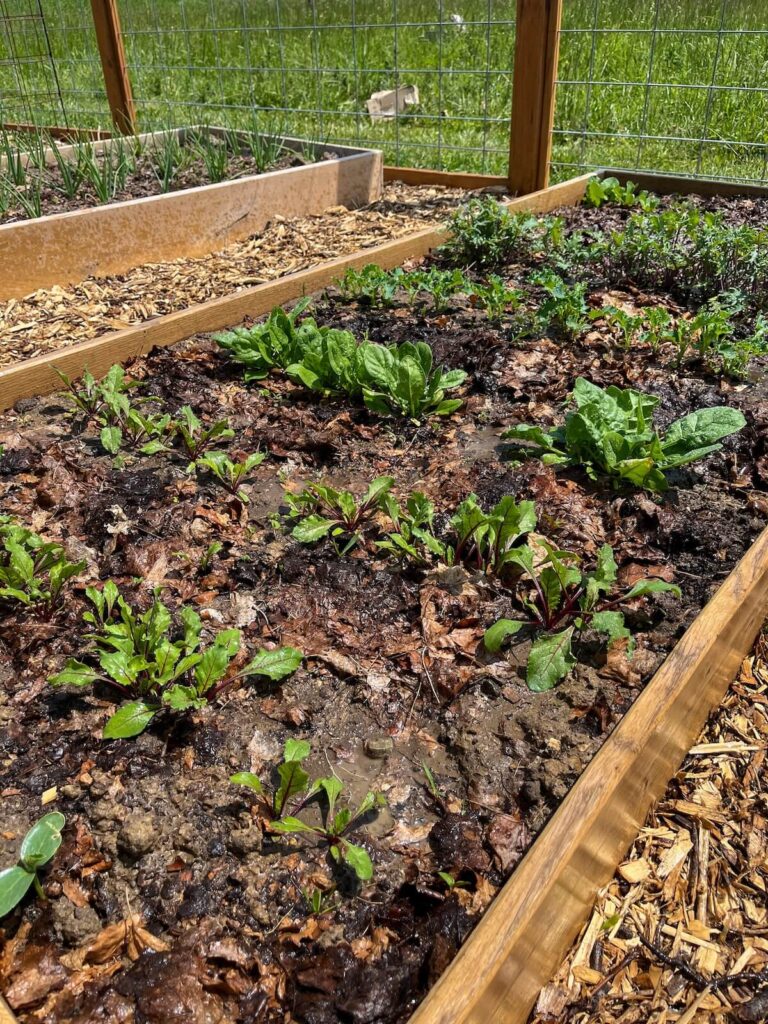
6. Garden Netting
For smaller gardens or areas that are especially prone to deer damage, garden netting or row covers can provide a quick and fairly inexpensive solution for keeping deer out. As a bonus, it also tends to protect plants from rabbits, insects (depending on how fine it is), and other garden pests.
7. Rock Garden Border
If you have access to a lot of rocks, another option is to create a rock garden permiter around your flower or vegetable garden. Deer don’t want to walk on rocks, so if they have to cross over a few feet of rocks (whether smaller stones or large boulders) to get into your garden, they will likely lose interest pretty quickly.
8. Let the Dog Out
A dog can actually be a highly valuable investment in keeping your garden protected from deer—but the conditions have to be right. Of course, in order for a dog to scare deer away, it has to be active (and preferably loud) and in the right area. If your garden’s a half mile away and the dog stays near the house, it probably won’t help much.
Remember, deer like to come around near dusk and dawn. If you’re noticing deer activity and damage during these times and you have the ability to let the dog out, it’s definitely worth a try!
Obviously, this isn’t always an effective deterrent in every situation. Deer can also get used to dogs if the dogs never get close to the garden or tend to be really subdued. However, gardeners with loud dogs that are active outside at the right times often have minimal deer problems.
9. Fishing Line
Some gardeners swear by invisible fishing line around the garden as a deer deterrent. The idea is that the deer will get pretty close to the garden until they bump the line and get scared away. For this method, you’ll want to string invisible line around your garden at different heights, stringing it a foot or two wider than the border of the garden. (If it’s right up next to your plants, the deer might not even end up touching it when they reach in for a bite.)
One downside of this method is that invisible fishing line also has the potential to trip up and tangle dogs or other animals.
10. Dollar-Store Deterrents
If you’re just trying to get through the season, it’s worth trying some cheap and easy deterrents to hopefully scare the deer away from your garden, at least for awhile. There are plenty of flashy, noisy objects that can spook a deer that you can buy for a minimal cost or maybe even dig out of your kitchen cabinet.
They’re not always long term solutions and you may need to switch them up a couple weeks or so so the deer don’t get used to them, but they can be effective scare tactics for awhile at least! Here are some ideas:
- Pie tins. Punch a hole in some disposable aluminum pie tins and hang them from a string around your garden. The flashy silver and blowing noise can be effective for intimidating the deer.
- Pinwheels. Stick some pinwheels around your garden! These can also be good for creating some movement and even noise in windy weather.
- Plastic bags. We’ve tied plastic grocery bags around each post of our garden to keep deer out. The deer got used to them after awhile, but they did work for a few weeks!
Other Methods You Can Try (Honorable Mentions)
There are dozens of other methods that gardeners try for keeping deer out, from predator urine and human hair to making homemade deer repellent out of raw eggs (yep). We’ve personally tried most of the methods above, but every area is different! If a tall fence, barking dog, or pie tin seems a little too boring to you, here are some other methods you might want to try.
- Strong scent. Deer dislike strong smells. Gardeners have used rotten eggs or commercial putrescent egg sprays around the garden. You can also try other strong-smelling options around your garden’s perimeter such as blood meal, shavings from a bar of soap (plenty of gardeners swear by Irish Spring soap), cayenne pepper, or even human scents. In suburban areas especially, however, these options aren’t always effective for intimidating deer, and they typically need to be reapplied after a rain.
- Deer-resistant plants. While not always the most effective method, deer-resistant are less likely to have much damage from deer, as long as they’re not too hungry. Some of the top deer resistant plants to try include yarrow, onion, snapdragon, asparagus, bleeding heart, lavender, mint, basil, and bee balm, among many others. It’s also helpful to keep in mind that in general, deer tend to avoid pungent plants, while they’re drawn to the tender leaves of young plants.
- Motion-triggered devices. Motion-activated devices and ultrasonic deer repellers can be effective, but deer typically get used to them after awhile. For best results, you’ll want to switch up the pattern and/or device.
- Commercial repellents. There are many different types of repellents on the market for deterring deer.
Pin This Post! ⬇️
